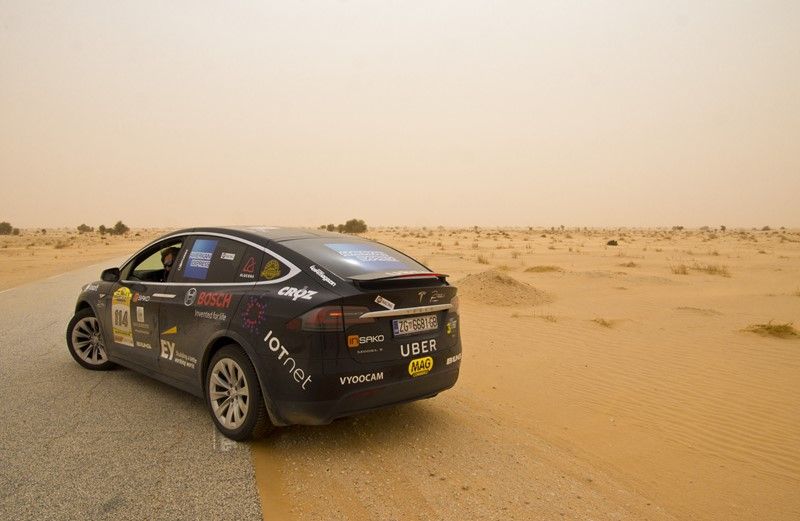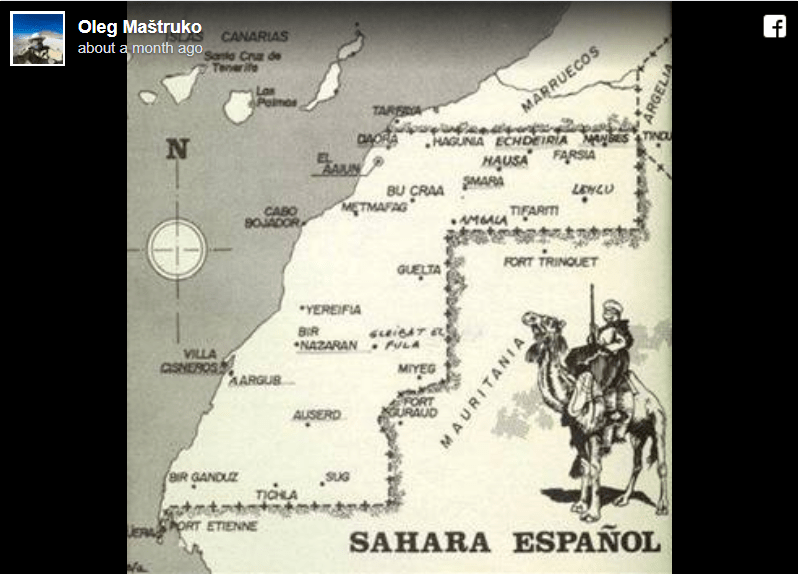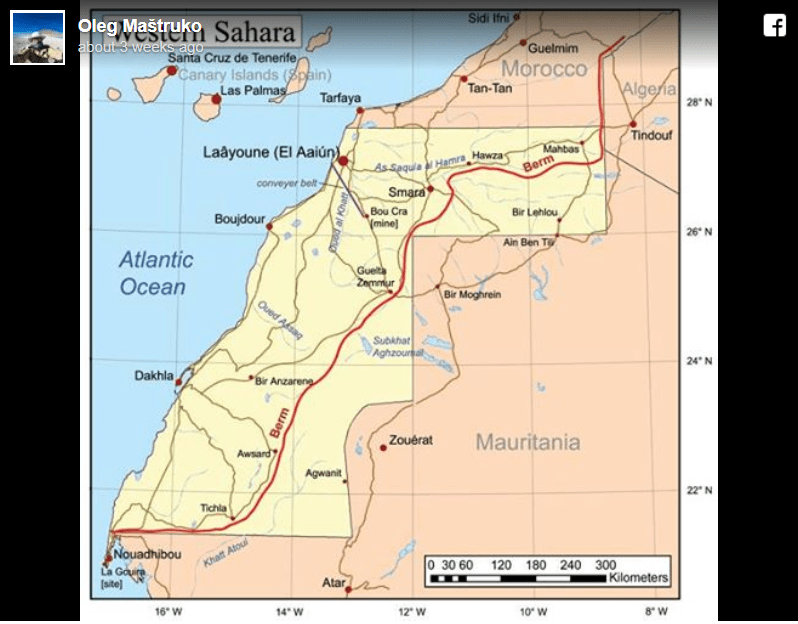After a period of radio silence,our intrepid Croatian adventurists, Sasa Cvetojevic and Oleg Mastruko, are making fantastic progress in their bid to become the first electric car to complete the Budapest to Bamako Rally. A fantastic update from Oleg on their recent travails on January 24, 2018.
A naïve attempt to visit a nearby beach ended up with getting stuck in sand. Tedious extraction resulted in a destroyed tire, when we discovered that the spare tire’s size does not fit our service vehicle. And then a sand storm, while the generator noise is a story of its own, making us spend nights outside of camp.
After Ourzazate we entered the real desert and began our attempt of entering the Guinness Book of World Records – the first Sahara crossing with an electric vehicle!
After a huge leg (and a portion of the next one) from Ourzazate to Tiznit, we spent the night as one of the most remote teams at the rally. I purposely say remote, not leading, as this is not a race, especially not for us. After the third leg officially ended, we purposely began the fourth, as the fourth is huge, so to get as much done as we can. Upon arriving in Tiznit we came across several other teams who shared our strategy, but with regular, non-electric vehicles. As the town offered no charging options, we pushed further south, found a quiet place and camped in the dark with the buzz of the generator, perhaps further away from anyone at the rally.
Our mornings are notoriously inefficient in preparations, so that advantage was immediately lost.
The next leg Tafrout - Laayoune, is with 620 kilometers officially the longest at the rally. Laayoune or Al Ayoun is the largest town in Western Sahara, a disputed area (mostly) occupied by Morocco. Charging was done at a messy and far overpriced 4-star hotel (realistically 2-star), and the wrong tri-phase outlet. An electrician had to come in to replace the outlet for the Tesla to top up by morning.
Fifteen kilometers south of Boujdour (or in Spanish Bojadora) is a very attractive beach with two shipwrecks. We rushed there to do a photo session with the Tesla, which we did at the beach entrance. We even taped on a GoPro for the spectacle of leaving the road to be better recorded. In the ‘hold my beer’ manner we took the Dacia support vehicle even further along the beach. The beach is huge, stretching a kilometer inland. We got stuck in sand and had the first ‘vehicle extraction’ drill. Much harder than any of us expected, although there was not much sand. Some nutcases, Lithuanians with Mercedes cars – a lot of Lithuanians at the rally – went even further although they saw our folly, I believe it took them all day to dig out.
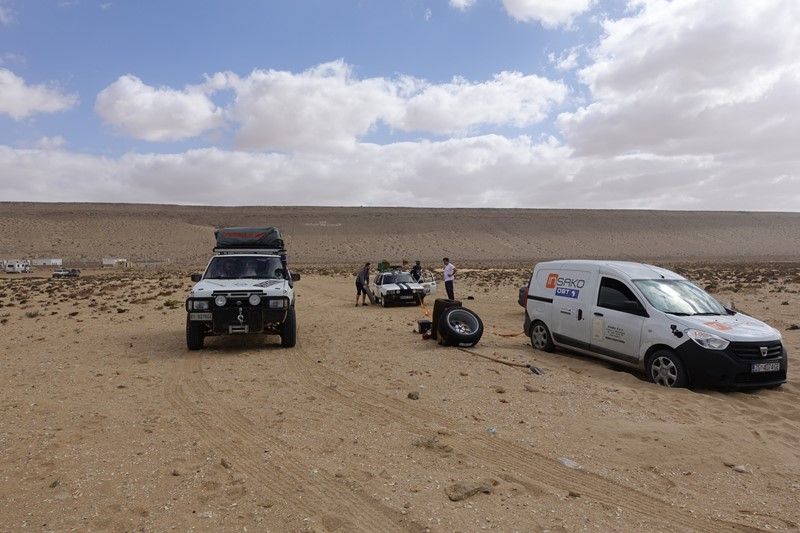
A slightly wiser Lithuanian with an old Passat remained at the edge of the sand, gave us a tug, we pushed and dug, so we managed to get out.
It was just the beginning of trouble, as our return to the road destroyed a tire on the Dacia. No problem, we’ll change it. We put the spare on, Saša rushed off with the Tesla, with Tomas and I set to follow. Like hell, the rim banged against the brake! Rims, specifically bought in Zagreb for Dacia, were not for Dacia! We will not disclose the name of the dealer who so finely messed us up if he sponsors our next expedition We tried a repair kit, which fills the tire from the inside with a foam, lost another half hour, but it didn’t work (and people say it never works for anyone).
I have to admit that was the first moment of slight desperation, and a feeling we won’t make it. The pressure on completing legs is huge, we have to stay in the group, while we were in a situation of our support vehicle stuck in the middle of the desert without a way to get it going. Plan B (or Z) was to stop someone from the rally, hitch a ride back to Boujdour with the burst tire, find a repair shop… lost XY hours… all over ‘hold my beer’ and ‘Let’s Instagram this” nonsense!
We stopped some Hungarians, several vans and jeeps. They were ready to take us to Boujdour, gathering around the car, studying, discussing in their language. The spirit of mutual assistance at the rally is strong, one of the reasons to take part. Then, an older Hungarian, probably the only one who didn’t get out of his car, advised to put the back wheel of the Dacia on the front one, and use the spare on the back wheel. A Buddha from Budapest! He didn’t even get out of the car, like a character from a Tarantino movie who says two words and disappears. We did so and moved on.
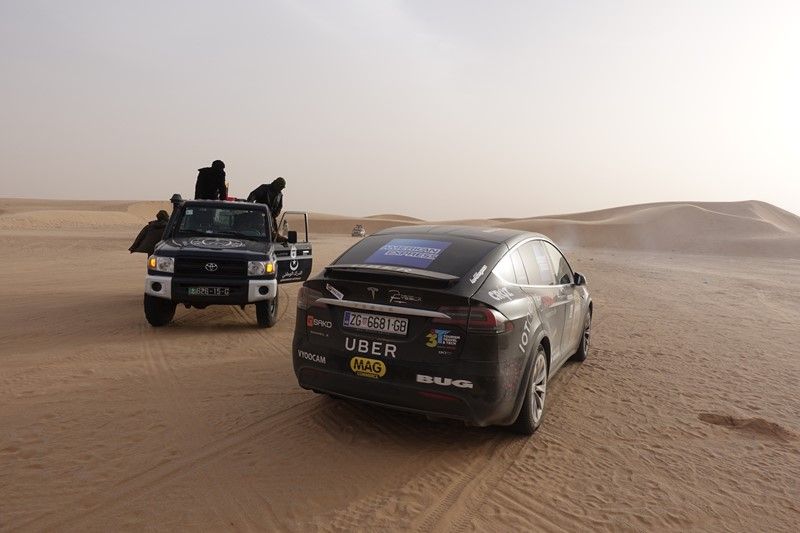
At the end of the day we also messed up finding the accommodation in Dakhla, used the generator more than we needed, watching over it throughout the night and refilling with gasoline, but we were deep into leg six, somewhat smarter and more experienced, still in the game.
The sixth leg, Dakhla - Bou Lanoar, the most problematic due to the border crossing of Western Sahara and Mauritania. In length, the 407 kilometers are not huge and we counted on covering it with one charge. The charging in Dakhla was loaded with problems (as almost all the ones where we used the generator), with night watches and refueling, but we started out in good spirit. Besides the border, there were no other major issues or especially interesting things requiring us to deviate from the course.
The political situation in Western Sahara was described in the preparation phase on our Facebook page, but to most it was not interesting then, so here is a repeat:
Morocco occupied Western Sahara, whose independence is being fought for by the guerilla and political movement Polisario. Morocco has control over most of the territory and almost the entire shoreline. In the south, where Moroccan control ends, there is a 3-kilometer wide band of no man’s land, partially controlled by Polisario, partially UN, and mostly nobody. This is how the roadbook describes that band:
There is the military buffer zone under UN control on the other side of the gate – this is the actual Western Sahara, i.e. the area liberated by Polisario. It is known as the “No-man’s Land” to everybody. It is characterized by lawlessness, chaos, waste, cars discarded and blown up and vehicles left here because of various insurance fraud issues. Warning! As this is a territory without law, there is no military force or police who could protect you, but there are lots of mines. Stay always on the trodden trail and keep left!
Well, quite fun. The zone looks like a scene for a zombie apocalypse, with car wrecks and strange characters wandering around like zombies.
After this comes the Mauritania border, one of the most bizarre ones ever. Basically an extension of no man’s land and the lawlessness. Some soldiers or people dressed as soldiers waving something, banging on the glass and hood, asking for something… Third world all the way. We came through, as experienced travelers, monitoring only the state of the battery. We drove the 55 kilometers to Bou Lanoar super slowly, with the Dacia ahead of the Tesla to reduce air resistance, with the roadbook advising to avoid stopping in Mauritania during day as well, let alone at night. It is hot and there is nothing but desert by the road. Occasionally a 30-year-old Mercedes would pass by.
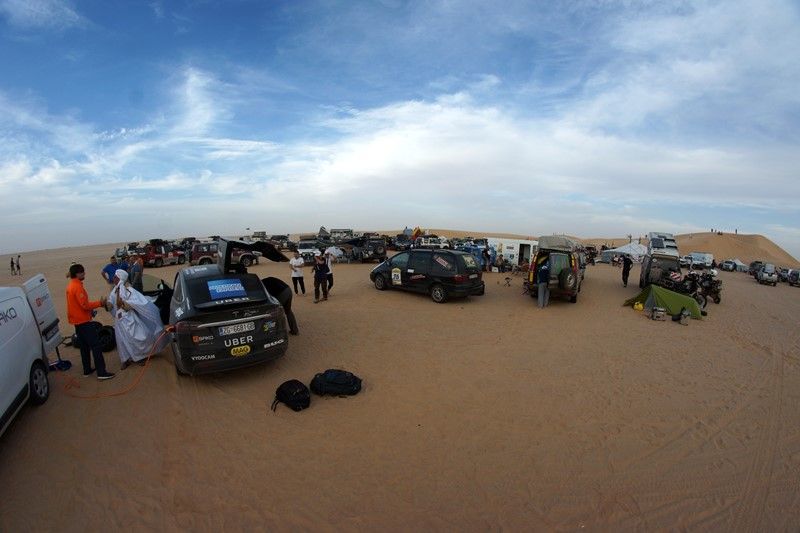
Camp Bou Lanoar! It is two kilometers from the main road, on semi-sandy terrain. We probably could have made it to the camp without a recharge, which would have brightened up the rest of our day, night and the following day, but life and the rally had other plans. Consumption, range and driving optimization of electric vehicles should best be commented on by the expert – Saša. Trust me that we did not feel like stopping on a Mauritania road without a dire need.
Despite the apocalyptic scenes, the border crossing was unexpectedly easy. In Mauritania we crawled as snails, using up the last electrons in the battery. 15 kilometers from camp we had to stop for a quick recharge. As the roadbook truly advises against stopping, we did so hastily, just enough to get to camp (which is protected by the army).
But camp was not by the main road but 2km further, across sand! This meant another recharge at the turnoff (two in only 15km – bad) and planning tactics to get the Dacia to camp. We will surely not camp without the protection of the army…
Take into account that each recharge means unloading heavy stuff from the Dacia before starting up the generator. Although we arrived at camp in a good mood, things went downhill later on…
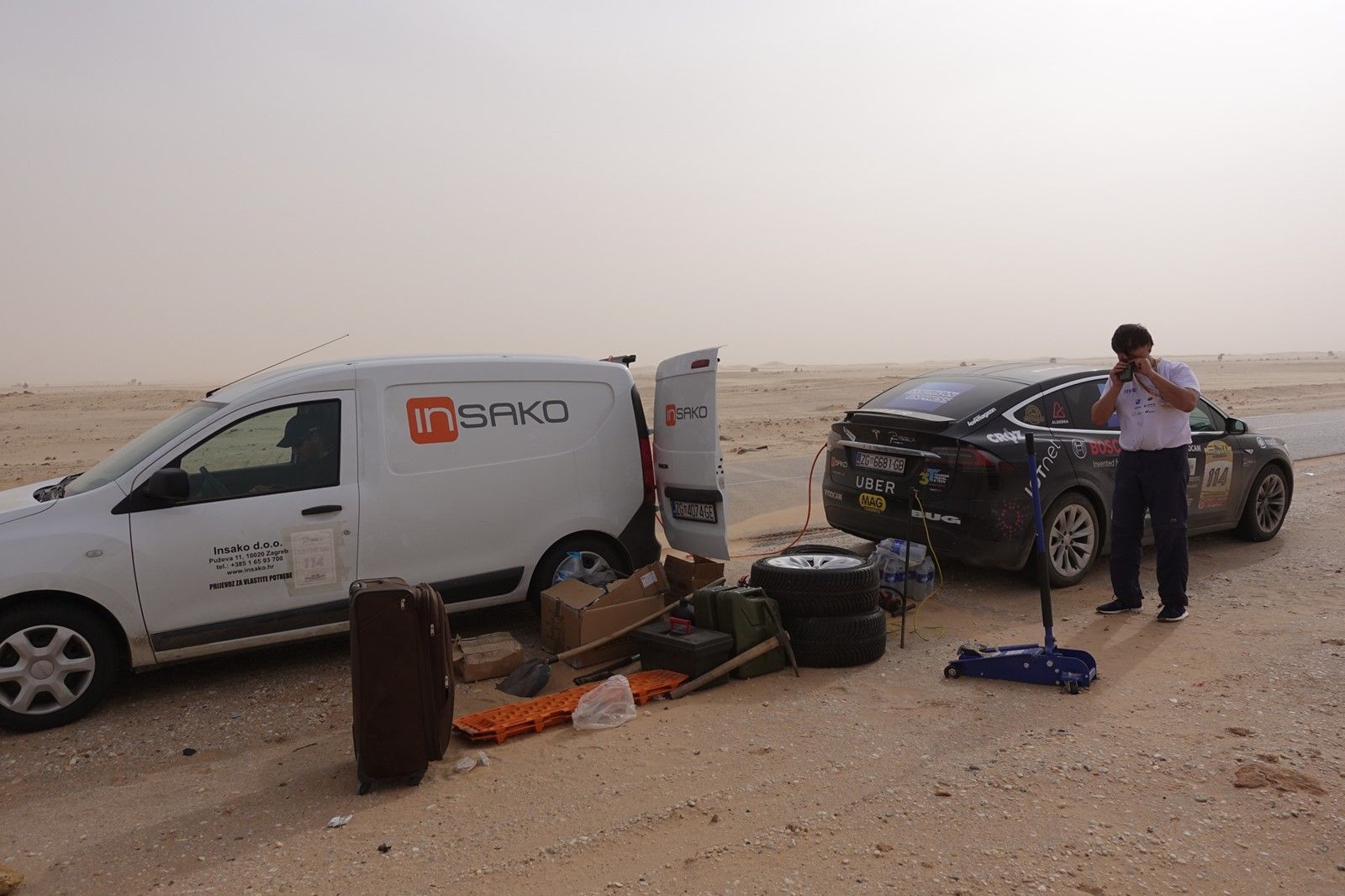
Neither of us three, especially me, are camping aficionados for the camping experience. It’s ok, but we are more interested in other things beyond the setting up of a tent, cold chow from cans and sleeping on uncomfortable mats and sleeping bags. We will do it for a bigger cause (photography, adventure, ride, airsoft…), but not for the camping itself.
I passed out from exhaustion in my tent around 21h. Later I overheard an argument when some fussy Hungarians came over and demanded form Saša and Tomas to shut down the generator. A generator, in the desert, in Mauritania, is not a joke for us but a matter of life and death. Saša and Tomas parked with utmost care, at the edge of camp, downwind and with Dacia doors toward the outside of camp. In my opinion it wasn’t that noisy, and I was sleeping closest to the noise. Along with that, we were ready to allow anyone to refill their gadgets from the generator, which many took advantage of. And we planned to shut it off at midnight. Some did not find this enough and we had to stop charging and move the vehicles another fifty meters further – inconvenient in many ways. As a consequence we will avoid campsites in the future.
Due to bad grounding, and grounding on sand is impossible, with the described accumulated problems of the day before and that evening, the charging was going very slowly. In the morning the pumped up nutcases with their 4x4s began leaving camp before sunrise. We all slept poorly, I was aching all over, the group was leaving camp, our car wasn’t loaded, everything was shit… but we had to move from there as this is Mauritania and the army protection will also leave soon.
The Dacia got stuck in the sand at this second camp location (all over 2-3 aholes who were bothered by noise). The Croatian team, in a rush themselves, was helping us, but we were eventually rescued by one of the lighter terrain vehicles, from a competitive or at least serious off-road team. And the one who did so was also Hungarian, just like those who forced us to move, so the Hungarian effect was thus annulled.
One hundred million hours and units of energy were lost on this.
I was useless in all of this that morning, I could not get my thoughts together (not that I am much more useful usually, but then I was completely useless), Saša and Tomas did everything, in the best possible way, Saša got into survival mode and Tomas is cool even under pressure. I am a whiny IT guy. We dragged the cars onto the main road, the Dacia did not get stuck, Tomac floored it so it flew to the other side of the road. Soldiers helped out with the loading of equipment.
Enough of the bad mood - on the main road, with just over half a battery in the Tesla, with a rising sand storm, without military protection and with teams passing us by south bound while we stopped – we concluded that: a) we suck; b) we should avoid camps; c) we definitely avoid any off-road with the Dacia!
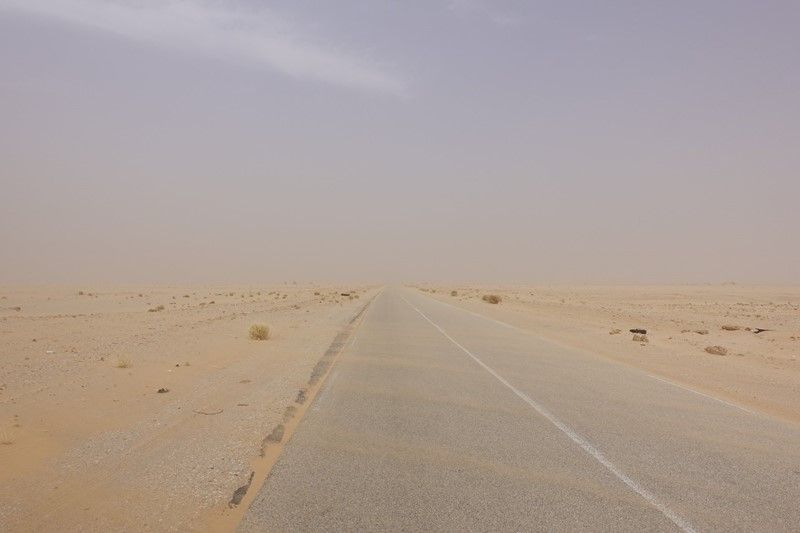
Tomas and Saša are people for the toughest missions, my recollections of those moments are a mixture of nightmares, semi-consciousness and a 30-second nap in the Dacia, with the generator howling 30 centimeters behind me.
The mood grew from the lowest point with two things – hours have passed without anyone killing or kidnapping us and the battery was charging. After what seemed like an eternity, in reality around 13h, the battery was full and ready to march to Nouakchott! We were back in the game, sleep-deprived, head and muscle pains, but moving on. We thought we were the last of all teams - but were much better than that, but were surely the last to leave camp, bad and twisted on its own.
The sand storm was by the in full swing – it may not look like much, but the wind carries anything not tied down or massive and pushes sand into all pores and openings. Visibility is a few hundred meters at most. Any car or truck in the opposite direction drops sand on us. And the entire atmosphere is unhealthy and depressing.
The official leg for that day sent competing 4x4 teams into inland Mauritania, and others for a beach ride, to the so-called B2 camp. The sand storm and the unattractive off-road ride made most teams give up on camping at B2 and proceeded straight to Nouakchott. This went along great with our plans to avoid camping and driving on sand. We needed rest, distance from other teams with noise issues and a normal charge, even from a regular outlet.
Follow Team Tesla - RWE and their amazing journey on Facebook.
